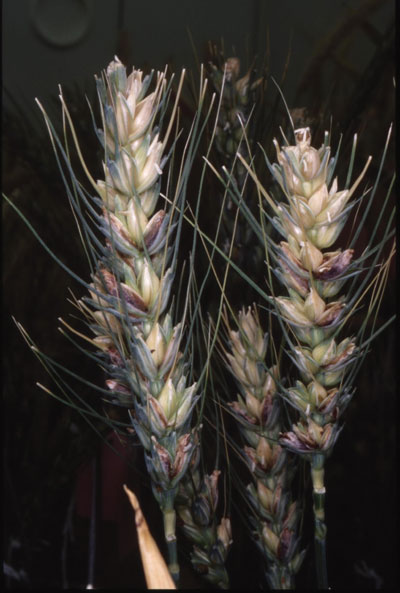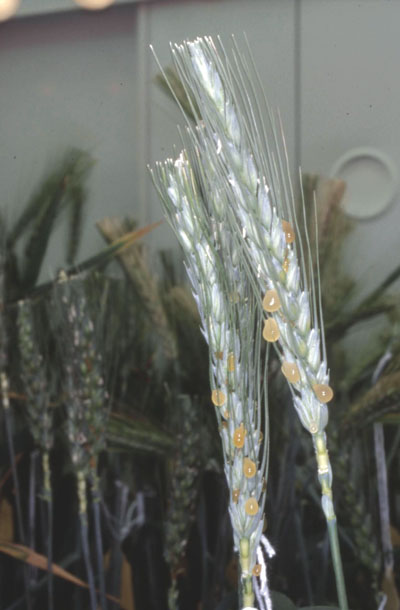
Features
Agronomy
Diseases
Ergot Review: Was 2009 as bad as 2008?
Across many parts of Western Canada in 2008, cool, wet conditions during the growing season provided the right conditions for ergot infection. However in 2009, the scope and magnitude of the ergot infection was greatly reduced.
April 30, 2010 By Donna Fleury
Across many parts of Western Canada in 2008, cool, wet conditions
during the growing season provided the right conditions for ergot
infection. However in 2009, the scope and magnitude of the ergot
infection was greatly reduced.

|
|
| Ergot bodies or scelortia infection on wheat in AAFC trials. (Photos courtesy of Mike Shillinglaw, Agriculture and Agri-Food Canada.) | |

|
|
| Secondary ergot infection stage where “honeydew” or sticky ergot spores are produced at the flowering stage in AAFC trials.
|
“We’re still trying to assess the scope of the 2009 ergot situation,
but it looks like generally the problems are much less than expected,”
says Mike Grenier, agronomist with the Canadian Wheat Board. “The
overall wheat quality grade pattern for the 2009 harvest was high, and
where there was downgrading, diseases such as fusarium and mildew
seemed to be a bigger problem than ergot.”
Ergot issues were still prevalent in eastern Saskatchewan, western
Manitoba and other isolated areas in 2009. “Even though ergot was not a
big issue in 2009, concerns from the 2008 infection year are not over,”
explains Grenier. “To get out of the 2008 ergot infection load, we
really need two years, so growers should try to avoid wheat for at
least two years in heavy ergot-infected areas.”
Ergot is caused by the Claviceps purpurea fungus that affects most
cereals, in particular rye, triticale, wheat and grasses. The fungus
forms in place of the kernel prior to harvest, reducing grain yield and
quality. Ergot is poisonous to humans and animals, with the Canadian
Grain Commission allowable level of ergot in #1CWRS wheat of .01
percent, while feed grain is 0.10 percent.
Using the 2008 infection to understand the life cycle, the ergot bodies
return to the soil in the fall after harvest. In the spring of 2009,
those ergot bodies started to germinate in June and release spores that
infected the wheat during the flowering period. This primary infection
stage is followed by a secondary infection stage where “honeydew” or
sticky ergot spores are produced at the flowering stage. Insects are
attracted to the honeydew and can transport the sticky spores to other
wheat spikes, causing secondary infections. Ergot bodies are newly
formed in infected flowers and are returned to the soil after the 2009
harvest to continue the cycle and be a source of infection for the 2010
crop.
Cultural practices and prevention are the only management strategies
now available to growers. There are no resistant varieties available
and currently no chemical control products registered for seed
treatment or in-crop ergot control. “The two key field management
strategies are crop rotation and using clean seed,” says Grenier. “In
fields where ergot was problematic, growers should be rotating away
from wheat for at least two years.”
Growers should always use clean seed to reduce the risk of introduction of ergot into fields.
Another important management strategy is headland sanitation. Because
ergot infects a wide range of cereals and grasses, mowing ditches and
field edges before grasses begin to flower is important for reducing
the ergot infection load. Clipping the grasses before flowering reduces
the risk of infection from both the production of ergot bodies and the
secondary honeydew infection.
The fungal spores infect plants at the flowering stage, so using good
agronomic practices to ensure uniform stands can reduce the time of
flowering in the crop. Under conducive conditions, the more extended
the flowering period of the crop, the higher the risk of ergot
infection.
There are also harvest management strategies that can help address
ergot problems. “Because ergot infection tends to be higher along the
headlands, consider harvesting and binning those areas separately from
the rest of the field to prevent contamination of the whole field
production. “Sometimes the ergot bodies will shatter out, so delaying
harvest may reduce the amount of contamination in the grain,” says
Grenier. “However, it doesn’t prevent the ergot bodies from going into
the soil and causing future problems.”
Much of the ergot can be removed through grain cleaning, but it takes
time and a lot of clean grain can be removed at the same time. The
ergot-infected screenings can be a source of infection in future years
if not disposed of properly. To prevent future problems, contaminated
screenings not suitable for feed should be disposed of by burning or
deep burial. “Although we were very concerned about the potential ergot
problem in 2009 based on the high inoculum levels from 2008, the
problems were much less than we expected,” says Grenier. “However,
growers in infected areas must still use best practices, including two
year rotations between wheat crops, to reduce the potential for
infection in 2010.”
|